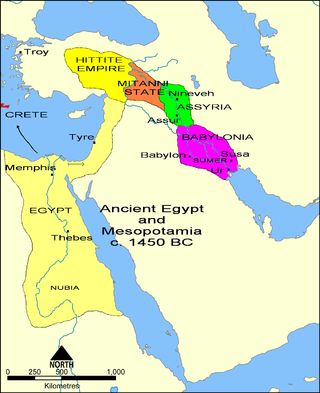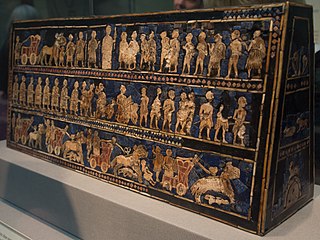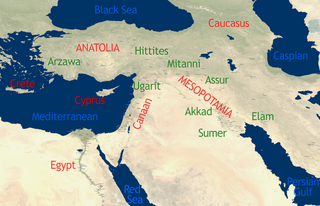Related Research Articles

The Bronze Age was a historical period lasting from approximately 3300 to 1200 BC. It was characterized by the use of bronze, the use of writing in some areas, and other features of early urban civilization. The Bronze Age is the middle principal period of the three-age system, between the Stone and Iron Ages. Worldwide, the Bronze Age generally followed the Neolithic period, with the Chalcolithic serving as a transition.
The 2nd millennium BC spanned the years 2000 BC to 1001 BC. In the Ancient Near East, it marks the transition from the Middle to the Late Bronze Age. The Ancient Near Eastern cultures are well within the historical era: The first half of the millennium is dominated by the Middle Kingdom of Egypt and Babylonia. The alphabet develops. At the center of the millennium, a new order emerges with Mycenaean Greek dominance of the Aegean and the rise of the Hittite Empire. The end of the millennium sees the Bronze Age collapse and the transition to the Iron Age.
The 3rd millennium BC spanned the years 3000 to 2001 BC. This period of time corresponds to the Early to Middle Bronze Age, characterized by the early empires in the Ancient Near East. In Ancient Egypt, the Early Dynastic Period is followed by the Old Kingdom. In Mesopotamia, the Early Dynastic Period is followed by the Akkadian Empire. In what is now Northwest India and Pakistan, the Indus Valley civilization developed a state society.
The 12th century BC is the period from 1200 to 1101 BC. The Late Bronze Age collapse in the ancient Near East and eastern Mediterranean is often considered to begin in this century.

The 15th century BC was the century that lasted from 1500 BC to 1401 BC.
The 16th century BC was a century that lasted from 1600 BC to 1501 BC.
The 1200s BC is a decade which lasted from 1209 BC to 1200 BC.

Babylonia was an ancient Akkadian-speaking state and cultural area based in the city of Babylon in central-southern Mesopotamia. It emerged as an Akkadian populated but Amorite-ruled state c. 1894 BC. During the reign of Hammurabi and afterwards, Babylonia was retrospectively called "the country of Akkad", a deliberate archaism in reference to the previous glory of the Akkadian Empire. It was often involved in rivalry with the older ethno-linguistically related state of Assyria in the north of Mesopotamia and Elam to the east in Ancient Iran. Babylonia briefly became the major power in the region after Hammurabi created a short-lived empire, succeeding the earlier Akkadian Empire, Third Dynasty of Ur, and Old Assyrian Empire. The Babylonian Empire rapidly fell apart after the death of Hammurabi and reverted to a small kingdom centered around the city of Babylon.

Ancient history is a time period from the beginning of writing and recorded human history through late antiquity. The span of recorded history is roughly 5,000 years, beginning with the development of Sumerian cuneiform script and continuing until the expansion of Islam in late antiquity. Ancient history covers all continents inhabited by humans in the period 3000 BC – AD 500. The three-age system periodizes ancient history into the Stone Age, the Bronze Age, and the Iron Age, with recorded history generally considered to begin with the Bronze Age. The start and end of the three ages vary between world regions. In many regions the Bronze Age is generally considered to begin a few centuries prior to 3000 BC, while the end of the Iron Age varies from the early first millennium BC in some regions to the late first millennium AD in others.

The Kassites were people of the ancient Near East, who controlled Babylonia after the fall of the Old Babylonian Empire c. 1531 BC and until c. 1155 BC.

Mitanni, earlier called Ḫabigalbat in old Babylonian texts, c. 1600 BC; Hanigalbat or Hani-Rabbat in Assyrian records, or Naharin in Egyptian texts, was a Hurrian-speaking state in northern Syria and southeast Anatolia with Indo-Aryan linguistic and political influences. Since no histories, royal annals or chronicles have yet been found in its excavated sites, knowledge about Mitanni is sparse compared to the other powers in the area, and dependent on what its neighbours commented in their texts.

Ancient art refers to the many types of art produced by the advanced cultures of ancient societies with different forms of writing, such as those of ancient China, India, Mesopotamia, Persia, Palestine, Egypt, Greece, and Rome. The art of pre-literate societies is normally referred to as prehistoric art and is not covered here. Although some pre-Columbian cultures developed writing during the centuries before the arrival of Europeans, on grounds of dating these are covered at pre-Columbian art and articles such as Maya art, Aztec art, and Olmec art.

This timeline tries to compile dates of important historical events that happened in or that led to the rise of the Middle East. The Middle East is the territory that comprises today's Egypt, the Persian Gulf states, Iran, Iraq, Israel and Palestine, Cyprus, Jordan, Lebanon, Oman, Saudi Arabia, Syria, Turkey, United Arab Emirates, and Yemen. The Middle East, with its particular characteristics, was not to emerge until the late second millennium AD. To refer to a concept similar to that of today's Middle East but earlier in time, the term ancient Near East is used.
This timeline of ancient history lists historical events of the documented ancient past from the beginning of recorded history until the Early Middle Ages. Prior to this time period, prehistory civilizations were pre-literate and did not have written language.

The ancient Near East was the home of early civilizations within a region roughly corresponding to the modern Middle East: Mesopotamia, ancient Egypt, ancient Persia, Anatolia and the Armenian highlands, the Levant and the Arabian Peninsula. The ancient Near East is studied in the fields of ancient Near East studies, Near Eastern archaeology, and ancient history.

The chronology of the ancient Near East is a framework of dates for various events, rulers and dynasties. Historical inscriptions and texts customarily record events in terms of a succession of officials or rulers: "in the year X of king Y". Comparing many records pieces together a relative chronology relating dates in cities over a wide area.

The prehistory of Anatolia stretches from the Paleolithic era through to the appearance of classical civilisation in the middle of the 1st millennium BC. It is generally regarded as being divided into three ages reflecting the dominant materials used for the making of domestic implements and weapons: Stone Age, Bronze Age and Iron Age. The term Copper Age (Chalcolithic) is used to denote the period straddling the stone and Bronze Ages.

The Middle Babylonian period, also known as the Kassite period, in southern Mesopotamia is dated from c. 1595 – c. 1155 BC and began after the Hittites sacked the city of Babylon. The Kassites, whose dynasty is synonymous with the period, eventually assumed political control over the region and consolidated their power by subjugating the Sealand dynasty c. 1475 BC. After the subjugation of the Sealand dynasty, the Kassites unified the region of Babylonia into a single political entity. At the height of the Middle Babylonian period, the Kassite kings were engaging in commerce, trade, and organising diplomatic marriages with the kings of Egypt and other regional powers. However, after a period of gradual decline, the Middle Babylonian period collapsed with the fall of the Kassite dynasty c. 1155 BC. The collapse came as a result of an Assyrian invasion, that temporarily displaced the Kassites from their rule over southern Mesopotamia. Finally, the Elamites conducted various raids and eventually invaded Babylonian c. 1158 BC, which brought the Kassite dynasty and Middle Babylonian period to an end.
References
- ↑ Kim Ryholt, The Political Situation in Egypt during the Second Intermediate Period, Museum Tusculanum Press, (1997)